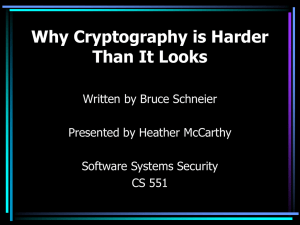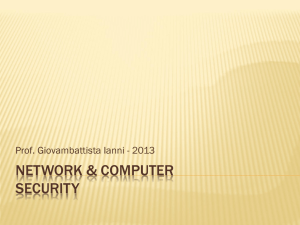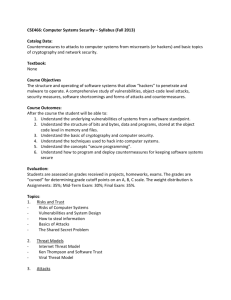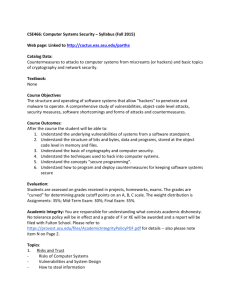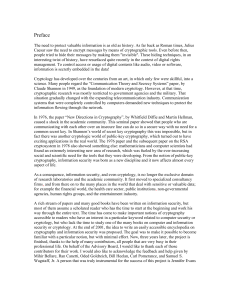Network Security - University of Engineering and Technology, Taxila
advertisement
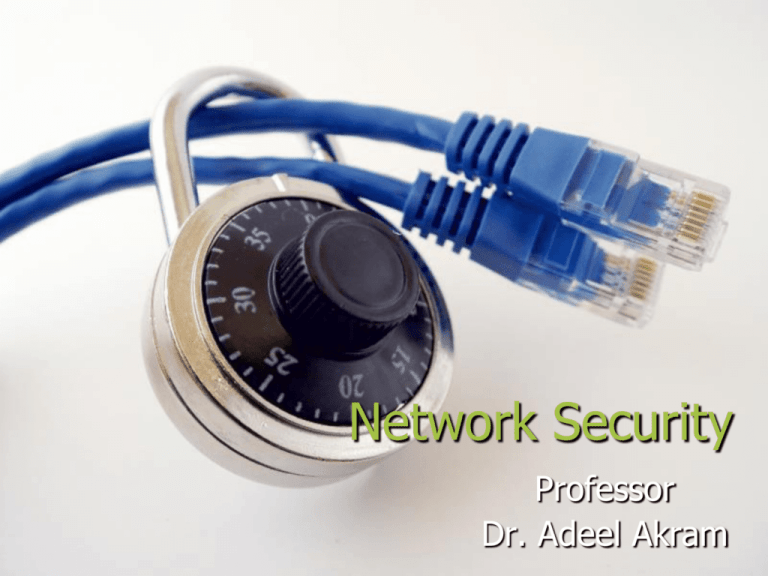
Network Security Professor Dr. Adeel Akram Introduction to Network Security Course Topics ► Security basics: services: integrity, availability, Authentication, etc., Basics of Cryptography attacks: interruption, modification ► Vulnerabilities and Counter Measures Viruses, worms, Trojan horses, backdoors, unused services ► Exploits Buffer Overflow, port scanning, NESSUS and related tools, incident handling and recovery ► Applications of Security System security, intrusion detection, remote authorization tools. Secure (commerce) Transactions over a network slide 3 Course Outline: Basic topics ► Security basics: Services integrity and availability, Authentication, etc. Attacks, Interruption, modification ► Vulnerabilities and Counter Measures Viruses, worms, Trojan horses, backdoors ► Applications of Security System security, intrusion detection, remote authorization tools. Secure (commerce) Transactions over a network ► Bio Authentication Types of Bio Authentication, Finger Prints, Retina Scans, Voice, DNA Algorithms for Bio Authentication ► Cryptography: Symmetric Cryptography, block ciphers, public-key cryptography, number theory, hash functions, key exchange slide 4 Course Outline: Network Security Architecture Physical and link layer Network layer Transport layer Application layer: DNS, RPC, NFS Application layer: Routing Wireless networks More secure protocols: DNSSEC, IPSEC, IPv6 slide 5 Course Objectives Introduction to concepts in ► Computer and Network Security: To understand vulnerabilities, threats, and counter measures present in computer and network systems. ► Bio Authentication: To understand different types of human characteristics and algorithms that are used for authentication ► Internet and Web Security: To understand TCP/IP and DNS security and have some practical experience in attacking and defending networked systems slide 6 Course Objectives ►Cryptography: To understand the formal tools available for securing data and services Understand fundamental algorithms in cryptology, risks and vulnerabilities of networked systems and network security, use existing protocols for network security to develop secure systems. slide 7 Text Books ► Network Security, Private Communication in a Public World, 2/E by C. Kaufman, R. Perlman, M. Speciner, Phi Learning (2009) ► ► Most of the topics from this book will be followed during this course. All relevant material will be provided as notes or as part of the class slides. slide 8 Text Books ► Cryptography and Network Security, by William Stallings, Prentice Hall, 4th Edition, 2006 ► ► Few topics from this book will be followed during this course. All relevant material will be provided as notes or as part of the class slides. slide 9 Text Books ► Network Security Essentials, by William Stallings, Prentice Hall, 2nd Edition, 2003 ► ► Few topics from this book will be followed during this course. All relevant material will be provided as notes or as part of the class slides. slide 10 Other Books ► Ross Anderson’s “Security Engineering” Focuses on design principles for secure systems Examples of banking, nuclear command and control, burglar alarms ► “The Shellcoder’s Handbook” Practical how-to manual for hacking attacks Not a required text, but will be extremely useful for the practical implementation of buffer overflow attacks slide 11 Occasional Assigned Reading ► Kevin Mitnick’s “The Art of Intrusion” Real-world hacking stories Good illustration for many concepts in this course ► Start reading “Smashing the Stack For Fun and Profit” by Aleph One (from Phrack hacker magazine) Understanding it will provide essential knowledge for exploiting and protecting OS stack vulnerabilities slide 12 Main Themes of the Course ► Vulnerabilities of networked applications Worms, denial of service attacks, malicious code arriving from the network, attacks on infrastructure ► Defense technologies Protection of information in transit: cryptography, application- and transport-layer security protocols Protection of networked applications: firewalls and intrusion detection slide 13 Main Themes of the Course ► Study a few deployed systems in detail: from design principles to gory implementation details Kerberos, SSL/TLS, IPsec slide 14 What This Course is Not About ► Not a comprehensive course on computer security ► Not a course on ethical, legal or economic issues No file sharing, DMCA, free speech issues ► Only brief overview of cryptography slide 15 What This Course is Not About ► Only some issues in systems security No access control, OS security, language-based security Very little about secure hardware Will cover buffer overflow: #1 cause of remote penetration attacks slide 16 Syllabus (1): Security Mechanisms ► Basics of cryptography Symmetric and public-key encryption, certificates, cryptographic hash functions, pseudo-random generators ► Authentication and key establishment Case study: Kerberos ► IP security Case study: IPsec protocol suite ► Web security slide 17 Case study: SSL/TLS (Transport Layer Security) Syllabus (2): Attacks and Defenses ► Buffer overflow attacks ► Network attacks Distributed denial of service Worms and viruses Attacks on routing and DNS infrastructure ► Defense tools Firewalls and intrusion detection systems ► Wireless security ► Spam and phishing slide 18 Peek at the Dark Side The only reason we will be learning about attack techniques is to build better defenses Don’t even think about using this knowledge to attack anyone slide 19 Motivation https:// slide 20 Excerpt From “General Terms of Use” YOU ACKNOWLEDGE THAT NEITHER WELLS FARGO, ITS AFFILIATES NOR ANY OF THEIR RESPECTIVE EMPLOYEES, AGENTS, THIRD PARTY CONTENT PROVIDERS OR LICENSORS WARRANT THAT THE SERVICES OR THE SITE WILL BE UNINTERRUPTED OR ERROR FREE; NOR DO THEY MAKE ANY WARRANTY AS TO THE RESULTS THAT MAY BE OBTAINED FROM USE OF THE SERVICES OR THE SITE, OR AS TO THE TIMELINESS, SEQUENCE, ACCURACY, RELIABILITY, COMPLETENESS OR CONTENT OF ANY INFORMATION, SERVICE, OR MERCHANDISE PROVIDED THROUGH THE SERVICES AND THE SITE. slide 21 “Privacy and Security” “As a Wells Fargo customer, your privacy and security always come first.” Privacy policy for individuals Online privacy policy Our commitment to online security Online and computer security tips How we protect you General terms of use slide 22 What Do You Think? What do you think should be included in “privacy and security” for an e-commerce website? ? slide 24 Desirable Security Properties ► Authenticity ► Confidentiality ► Integrity ► Availability ► Accountability and non-repudiation ► Freshness ► Access control ► Privacy of collected information ► Integrity of routing and DNS infrastructure slide 25 What Drives the Attackers? ► Put up a fake financial website, collect users’ logins and passwords, empty out their accounts ► Insert a hidden program into unsuspecting users’ computers, use them to spread spam ► Subvert copy protection, gain access to music and video files ► Stage denial of service attacks on websites, extort money ► Wreak havoc, achieve fame and glory in the blackhat community slide 26 Network Stack Phishing attacks, usability people email, Web, NFS application session transport network data link physical Sendmail, FTP, NFS bugs, chosenprotocol and version-rollback attacks RPC RPC worms, portmapper exploits TCP SYN flooding, RIP attacks, sequence number prediction IP 802.11 IP smurfing and other address spoofing attacks WEP attacks RF RF fingerprinting, DoS Only as secure as the single weakest layer… … or interconnection between the layers slide 27 Network Defenses People End users Password managers, company policies… Implementations Firewalls, intrusion detection… Blueprints Protocols and policies TLS, IPsec, access control… Building blocks Cryptographic primitives RSA, DSS, SHA-1… Systems slide 28 … all defense mechanisms must work correctly and securely Correctness versus Security ► System correctness: system satisfies specification For reasonable input, get reasonable output ► System security: system properties preserved in face of attack For unreasonable input, output not completely disastrous ► Main difference: active interference from adversary ► Modular design may increase vulnerability … ► … but also increases security (small TCB) slide 29 Bad News ► Security often not a primary consideration Performance and usability take precedence ► Feature-rich systems may be poorly understood ► Implementations are buggy Buffer overflows are the “vulnerability of the decade” Cross-site scripting and other Web attacks ► Networks are more open and accessible than ever Increased exposure, easier to cover tracks ► Many attacks are not even technical in nature Phishing, impersonation, etc. slide 30 Better News ► There are a lot of defense mechanisms We’ll study some, but by no means all, in this course ► It’s important to understand their limitations “If you think cryptography will solve your problem, then you don’t understand cryptography… and you don’t understand your problem” -- Bruce Schneier Many security holes are based on misunderstanding ► Security awareness and user “buy-in” help ► Other important factors: usability and economics slide 31 Reading Assignment ► Review Kaufman, section 1.5 Primer on networking ► Start reading buffer overflow materials on the course website (CMS) “Smashing the Stack for Fun and Profit” ► http://web.uettaxila.edu.pk/CMS/AUT2010/teNSbs slide 32 Why study computer security? ► ► ► ► ► (1) Computer security is fundamental to individual privacy. Many of us keep personal data on our accounts: emails, bookmarks, coursework. Many of us use the network to send personal data or retrieve personal data. Many remote computers keep personal data for us: financial data and accounts, medical history. We want to protect these resources. slide 33 Why study computer security? ► ► ► ► (2) Our society is increasingly reliant on the proper operation of networked computer systems, and integrity of their data. Financial and commercial operations, medical operations, meteorological, government, social welfare, and so one. (not to mention the Internet itself.) The protection of these systems is as vital as our dependence on the services they provide. An understanding to their limitations is vital. Exploited systems have resulted in people’s deaths. (Unavailable forecasts have caused a ship at sea to be lost.) slide 34 What is cryptology? ► Greek: “krypto” = hide ► Cryptology – science of hiding = cryptography + cryptanalysis + steganography ► Cryptography – secret writing ► Cryptanalysis – analyzing (breaking) secrets Cryptanalysis is what attacker does Decipher or Decryption is what legitimate receiver does slide 35 Steganography ► “Covered” messages ► Technical Steganography Invisible ink, shaved heads, microdots ► Linguistic Steganography “Open code” – secret message appears innocent ► “East wind rain” = war with USA Hide message in low-order bits in GIF slide 36 Cryptology and Security Cryptology is a branch of mathematics. Security is about people. slide 37 Terminology Insecure Channel Plaintext Alice Encrypt Ciphertext C = E(P) Eve P = D(C) E must be invertible Decrypt Plaintext Bob slide 38 Cryptography ► Always involves 2 things: Transformation Secret slide 39 Alice and Bob Plaintext Encrypt Ciphertext KE Encryption Key Alice Decrypt Plaintext KD Decryption Key C = E(KE, P) = EKE (P) P = D(KD, C) = DKD (C) If KE = KD it is symmetric encryption If KE KD it is asymmetric encryption Bob slide 40 Substitution Cipher ►C = EK(p) Ci = K[pi] ► Key is alphabet mapping: a J, b L, ... ► Suppose attacker knows algorithm but not key, how many keys to try? 26! If every person on earth tried one per second, it would take 5B years. slide 41 Monoalphabetic Cipher “XBW HGQW XS ACFPSUWG FWPGWXF CF AWWKZV CDQGJCDWA CD BHYJD DJXHGW; WUWD XBW ZWJFX PHGCSHF YCDA CF GSHFWA LV XBW KGSYCFW SI FBJGCDQ RDSOZWAQW OCXBBWZA IGSY SXBWGF.” slide 42 Frequency Analysis “XBW HGQW XS ACFPSUWG FWPGWXF CF AWWKZV CDQGJCDWA CD BHYJD DJXHGW; WUWD XBW ZWJFX PHGCSHF YCDA CF GSHFWA LV XBW KGSYCFW SI FBJGCDQ RDSOZWAQW OCXBBWZA IGSY SXBWGF.” W: 20 C: 11 F: 11 G: 11 “Normal” English: e 12% t 9% a 8% slide 43 Pattern Analysis “XBe HGQe XS ACFPSUeG FePGeXF CF AeeKZV CDQGJCDeA CD BHYJD DJXHGe; eUeD XBe ZeJFX PHGCSHF YCDA CF GSHFeA LV XBe KGSYCFe SI FBJGCDQ RDSOZeAQe OCXBBeZA IGSY SXBeGF.” XBe = “the” Most common trigrams in English: the = 6.4% and = 3.4% slide 44 Guessing “the HGQe tS ACFPSUeG FePGetF CF AeeKZV CDQGJCDeA CD hHYJD DJtHGe; eUeD the ZeJFt PHGCSHF YCDA CF GSHFeA LV the KGSYCFe SI FhJGCDQ RDSOZeAQe OCthheZA IGSY StheGF.” S = “o” slide 45 Guessing “the HGQe to ACFPoUeG FePGetF CF AeeKZV CDQGJCDeA CD hHYJD DJtHGe; eUeD the ZeJFt PHGCoHF YCDA CF GoHFeA LV the KGoYCFe oI FhJGCDQ RDoOZeAQe OCthheZA IGoY otheGF.” otheGF = “others” slide 46 Guessing “the HrQe to ACsPoUer sePrets Cs AeeKZV CDQrJCDeA CD hHYJD DJtHre; eUeD the ZeJst PHrCoHs YCDA Cs roHseA LV the KroYCse oI shJrCDQ RDoOZeAQe OCthheZA IroY others.” “sePrets” = “secrets” slide 47 Guessing “the HrQe to ACscoUer secrets Cs AeeKZV CDQrJCDeA CD hHYJD DJtHre; eUeD the ZeJst cHrCoHs YCDA Cs roHseA LV the KroYCse oI shJrCDQ RDoOZeAQe OCthheZA IroY others.” “ACscoUer” = “discover” slide 48 Guessing “the HrQe to discover secrets is deeKZV iDQrJiDed iD hHYJD DJtHre; eveD the ZeJst cHrioHs YiDd is roHsed LV the KroYise oI shJriDQ RDoOZedQe OithheZd IroY others.” slide 49 Monoalphabetic Cipher “The urge to discover secrets is deeply ingrained in human nature; even the least curious mind is roused by the promise of sharing knowledge withheld from others.” - John Chadwick, The Decipherment of Linear B slide 50 Why was it so easy? ► Doesn’t hide statistical properties of plaintext ► Doesn’t hide Higher statistics, i.e. relationships in plaintext (EE cannot match dg) ► English (and all natural languages) are very redundant ► Compress English with zip – about 1:6 slide 51 How to make it harder? ► Hide statistical properties: Encrypt “e” with 12 different symbols, “t” with 9 different symbols, etc. Add nulls, remove spaces ► Polyalphabetic cipher Use different substitutions ► Transposition Scramble order of letters slide 52 Network Security ► Most Computers require some kind of information sharing. ► Common mode of information sharing with other computers vary from Sneaker Nets to High Speed Networks. ► In order to secure individual computers, Network Security is the essential part. slide 53 Network Layer Vulnerabilities ►We'll discuss IPv4, although other protocols can be used at this level ►IP features Network addresses IP spoofing Fragmentation ►IP Components: ICMP ►Transport layer components dependent on IP: UDP TCP slide 54 IP Addresses ►Format "A.B.C.D" where each letter is a byte ►Class A network : A.0.0.0 Zeroes are used to indicate that any number could be in that position ►Class B network: A.B.0.0 ►Class C network: A.B.C.0 ►Broadcast addresses: 255.255.255.255 A.B.C.255 ►Special case 0.0.0.0 and A.B.C.0 can be either treated as a broadcast or discarded slide 55 Other IP Addresses ► Multicast (class D) 224.0.0.0 to 239.255.255.255 ► Class E (experimental, reserved, i.e., wasted) 240.0.0.0 to 254.255.255.255 slide 56 Junctions ►Router (gateway) Works at the network layer (e.g., IP) Joins subnets Tries to send packets on the best route ► Performs routing ►Firewall Packet filter that enforces policies (through its filtering) ► Can be transparent and non-addressable A firewall is not necessarily used as a router (might have only two interfaces), but it may A router is not necessarily a firewall Some configurations have firewalls behind routers slide 57 Special Networks ►Private non-routable networks 192.168.0.0 172.16.0.0 10.0.0.0 ►Loopback network 127.0.0.0 Typically only 127.0.0.1 is used slide 58 CIDR Addresses ►Classless Inter-Domain Routing Classes A, B, C too rigid Add flexibility on a bit level instead of byte level ►W.X.Y.Z/B B is the number of bits that constitute the network address /8 is class A /16 is class B /24 is class C slide 59 IP Packet ►Source IP ►Destination IP ►Checksum slide 60 IP Spoofing ►Any station can send packets pretending to be from any IP address ►Replies will be routed to the appropriate subnet Route asymmetry So, attacker might not get replies if spoofing a host on a different subnet ► For some attacks this is not important ►Analogy Nothing prevents you from physically mailing a letter with an invalid return address, or someone else’s, or your own. Likewise, packets can be inserted in the network with invalid or other IP addresses. slide 61 IP Spoofing with Amplification ►Use broadcasts pretending to originate from victim ►All replies go back to victim ►This may use any IP protocol (ICMP, TCP, UDP) Any application or service that replies using these protocols Famous attack: Smurf (using ICMP) DoS ►CERT® Advisory CA-1998-01 Smurf IP Denial-of-Service Attacks ►Many others ►Smurf Amplifier Registry: http://www.powertech.no/smurf/ slide 62 ICMP ►Internet Control Message Protocol (IP management) ►Error handling and debugging protocol ►Not authenticated! ►Encapsulated inside an IP header ►Message types: 40 assigned 255 possible about two dozen in use ►References: Network Intrusion Detection, http://www.iana.org/assignments/icmp-parameters slide 63 Basic ICMP Message Types ►0 Echo Reply ►3 Destination Unreachable ►4 Source Quench ►5 Redirect ►8 Echo ►11 Time Exceeded ►12 Parameter Problem ►13 Timestamp ►14 Timestamp Reply ►15 Information Request ►16 Information Reply slide 64 ICMP Echo ►a.k.a. Ping ►Destination replies (using the "source IP" of the original message) with "echo reply" ►Data received in the echo message must be returned in the echo reply ►How can this be abused? slide 65 Scans and Recon ►If an attacker wants to map your network, the trivial way is to ping all the IP addresses in your network... ►Therefore, if you allow pings, your network is exposed. slide 66 Smurf Attack ►Ping a broadcast address, with the (spoofed) IP of a victim as source address ►All hosts on the network respond to the victim ►The victim is overwhelmed ►Keys: Amplification and IP spoofing ►Protocol vulnerability; implementation can be “patched” by violating the protocol specification, to ignore pings to broadcast addresses ►ICMP echo just used for convenience All ICMP messages can be abused this way "Fraggle" is the equivalent, using UDP instead of ICMP slide 67 Other Ping Abuse ►Tribe, a.k.a. The "Tribe Flood Network" distributed denial of service attack tool ►Use ICMP echo request and reply as a secret communication channel to issue commands to infected computers Attackers reversed the normal usage of reply and request messages ►Reply messages used to issue commands and bypass firewalls ►http://staff.washington.edu/dittrich/misc/tfn.analysis slide 68 Why Do You Need Pings? ►To troubleshoot when something doesn’t work ►=> if everything works then you don’t need pings, especially pings from outside your network... ►CAN-1999-0523 (under review) ICMP echo (ping) is allowed from arbitrary hosts. slide 69 About These Slides ► You are free to copy, distribute, display, and perform the work; and to make derivative works, under the following conditions. You must give the original author and other contributors credit The work will be used for personal or non-commercial educational uses only, and not for commercial activities and purposes For any reuse or distribution, you must make clear to others the terms of use for this work Derivative works must retain and be subject to the same conditions, and contain a note identifying the new contributor(s) and date of modification ► Thanks to the support of Symantec Corporation slide 70 Questions ??????????????? ??????????????? ???? adeel.akram@uettaxila.edu.pk


